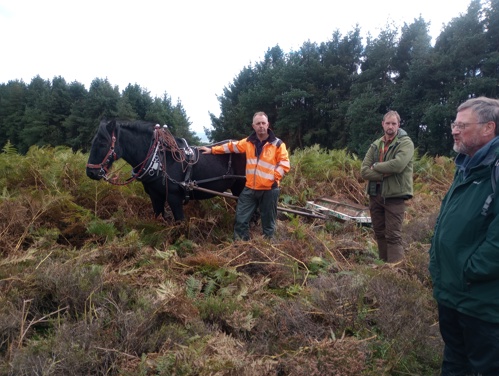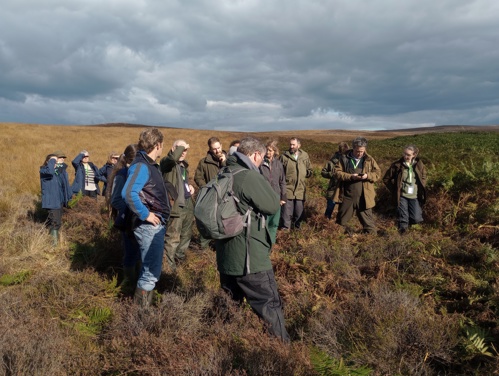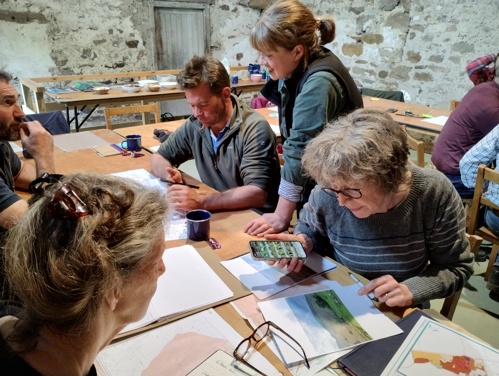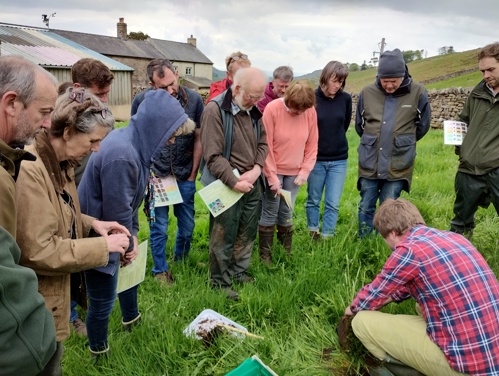





Bracken can have a strong impact on farming businesses, and can be a considerable burden across the managed national landscapes, impacting access, biodiversity, and health. Left unmanaged, bracken can spread across grazing land and outcompete important ground flora. However, bracken is also a valuable habitat for invertebrates, reptiles, small mammals and some moorland birds.
The group is looking for effective methods of managing bracken that will have a positive impact on both the farmers and wider custodians of these landscapes. They are focusing on the use of livestock for trampling, and where possible will include a comparison of mechanical management. The trial also aims to understand the effects of management on soil structure and health, as well as wider biodiversity, investigating changes in flora and fauna at trial sites.
The project will include trials on 8 farms, with a wider discussion group continuing around the trials, topic, and findings. The group includes Pasture for Life, and farmers in the Lake District, Yorkshire Dales, Forest of Bowland, Arnside & Silverdale, Nidderdale and North Pennines protected landscapes. Prof. Robin Pakeman from James Hutton Institute and advisors from local conservation organisations are also providing research and data collection support.
Methods of bracken control are varied and include cutting, pulling, rolling and grazing or broadcast feeding for trampling. Many farmers also used a Asulox which until recently was approved annually as part of an emergency authorisation process for use in bracken control. Asulox posed potential risks to the environment and human health, and is no longer available.
Whilst bracken can dominate grazing land, ground vegetation and important wildlife habitats leading to homogeneity, it can also benefit wildlife, particularly when maintained in a mixed environment such that only small patches occur. Bracken provides valuable nesting sites for birds and a warmer microclimate benefitting reptiles and essential for some invertebrates including rare butterflies found within the National Landscapes in this field lab. Therefore, part of the work seeks to understand how management affects the overall biodiversity of the sites.
Each site will choose an area to manage bracken with livestock through grazing or methods such as bale grazing or broadcasting hay on top of clumps of bracken to enable trampling. They will compare this to ‘no management’ and where possible ‘mechanical management’ methods such as strimming, cutting and rolling to bruise bracken stalks.
The following assessments will be used to assess management methods:
Participating farmers will receive training to facilitate accurate data collection for bracken growth, and general soil health monitoring, providing an opportunity to up-skill those involved and use the project budget efficiently. Local conservation organisations will undertake the wider biodiversity monitoring.
Watch the video of the non-chemical bracken management webinar for news from the bracken field labs, tips on bracken control and information on the new Bracken Management Learning Network.
After a delicious lunch at Denton Reserves' own pub the Penny Bun, a group of 30 field lab farmers, Protected Landscape Officers, Local Estate Managers and Farmer Advisors toured Denton Reserve before arriving on the moor to learn more about mechanical bracken management with Andrew Letten and his Dales Horse; Charlie.

Returning to the pub for refreshments, we then spent the remainder of the afternoon, giving an overview of the IF & PfL Bracken Field Lab, hearing from 2 of the 8 Field Lab Farmers Julia Horner from the Yorkshire Dales & Bill Grayson from Milnthorpe in Silverdale & Arnside.

Robin Pakeman academic partner from the James Hutton Institute gave a fascinating insight into the bracken plant, before Cumbrian farmer Paul Renison concluded the session by sharing how he has been successfully managing bracken with his herd of Aberdeen Angus herd of cattle, through focussed livestock impact, utilising bale grazing and salt block distribution in areas of high bracken density on the farm.

The afternoon finished with an engaged Q&A session and invitation to follow the bracken field lab's future progress with updates on the Innovative Farmers Website and IF & PfL Social media pages.
In this field lab, we are hoping to achieve a mosaic of habitats, rather than completely eradicate bracken.
Patches of dense, dead bracken provide warmer microclimates and are essential for providing habitats for butterflies at larvae stage, particularly the High Brown and Pearl Bordered Fritillaries - two of the most endangered butterflies in the UK, whose stronghold is the limestone hills surrounding Morecambe Bay. Bracken also provides shelter to allow flowering species to grow which feed fritillaries; species such as dog violets. However, too much bracken outcompetes other important flowering species associated with more acidic soils, so a balance is needed.
Under-grazing will mean bracken dominates and shades out other important plants, but over-grazing could wipe out too much bracken.
More information on the interactions between bracken and butterflies can be found in this leaflet by Butterfly Conservation.
The bracken management methods the farmers will trial in this field lab include:
The methods they are comparing it to include strimming and rolling.
The winter and spring into early June are good periods for control as the fronds are more brittle and quite easy to trample and damage. They are harder to damage in July and August.
Some of the group cannot graze the area during the winter; due to their Countryside Stewardship agreements, they are only permitted to graze between April and September.
To keep the stock in the trial areas, some are fencing, some are using cow collars and one farmer who cannot fence has deliberately chosen their control area in an area below scree where the cattle don't go.
The bracken management field lab group held their first in-person meeting today. The group spent the day discussing the plans for the trial, and being trained up in how to use the monitoring equipment.


Soil sampling training (photo credits Rebecca Swinn)
Robin explained that there has only been one previous study on the interactions between livestock and bracken.
Regarding growth of bracken through spores, Robin explained that it is very rare for bracken to establish from spores in the north of England.
We discussed the potential animal health risks associated with grazing in bracken-dominated areas. The group noted very few issues; cattle won't eat bracken fronds unless they really need to, i.e. if there is nothing else to eat, or occasionally eating young fronds (which are spore-free) in the spring if they're particularly curious.
We also discussed the other historical uses of bracken - as bedding, as a mulch/compost, and to make potash for soap and glass.
May 24
June 24
July 24
Spring '25
July '25
July '25
July '26
July '26

Soil Association
Northumberland
Tabitha joined the Soil Association from previous roles within the NFU as county advisor for Northumberland and AHDB as a Knowledge Exchange Manager within the Farm Economics and Beef and Lamb teams covering the North of England. This experience sits alongside farming at home with her partner on a hill farm in Northumberland producing pedigree sheep and cattle.
Tabitha’s academic background lies within the human health sector with a BSc Hons in Biomedicine and Nutrition and a MRes in Immunobiology from Newcastle University. Tabitha’s main focus is on the practical application of research within the farming sector and supporting businesses to be in the best position moving forward.

James Hutton Institute
NE Scotland

